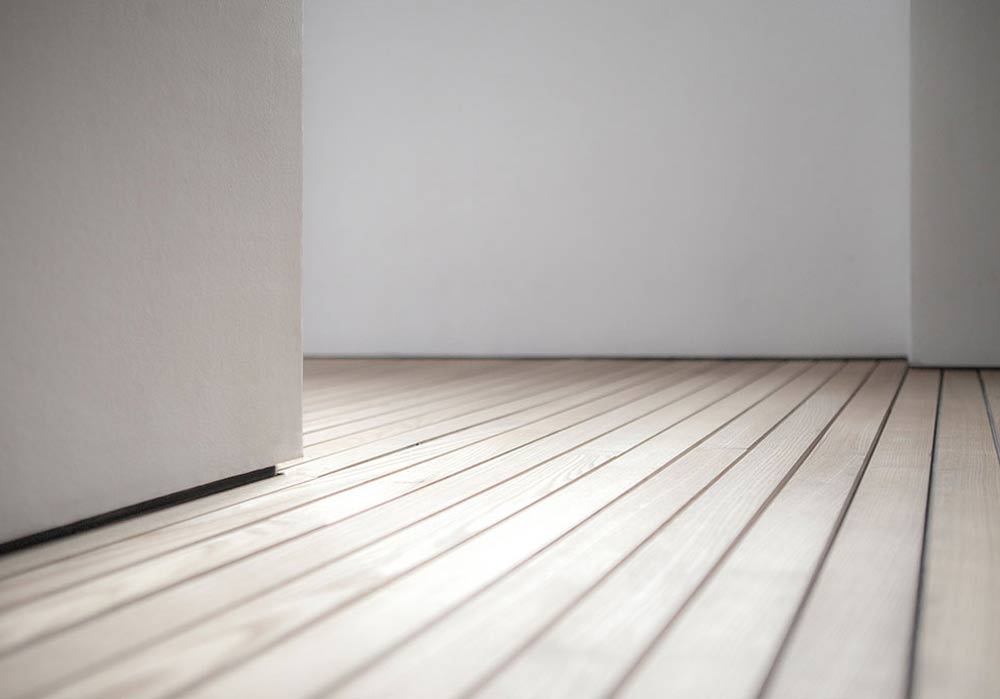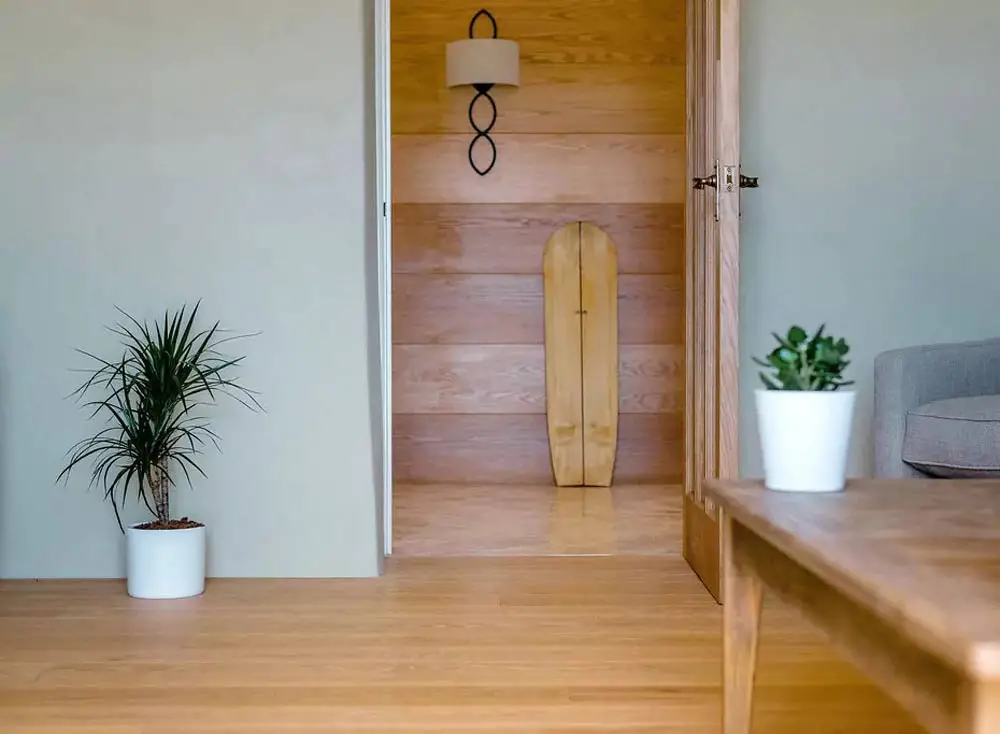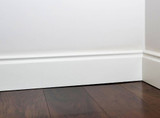Skirting boards, often just an afterthought in interior design schemes, play an important role in enhancing the aesthetics and functionality of a room. However, sometimes you may want to explore creative or practical alternatives that not only break away from the traditional but also infuse a unique character into your living spaces.
Although skirting board does a great job of protecting walls, there are various alternatives to skirting boards that can transform your home's appeal.
Disclaimer: As an Amazon associate, we do receive a small commission from qualifying purchases made via links within this article.
Say goodbye to standard skirting board finishes and look to redefine your interior spaces, with these credible alternatives to skirting boards.
Incorporate a Shadow Gap

Image credit: architects-adg.co.uk
A shadow gap, also known as a "reveal," is a design feature commonly used at the bottom of an internal wall instead of skirting board, particularly where the wall meets the floor.
This architectural element is a cool, modern and minimalist alternative to traditional skirting boards or baseboards in contemporary and ultra-modern houses.
Instead of covering the joint between the wall and the floor with skirting boards, a shadow gap leaves a narrow, recessed channel or gap that creates a subtle shadow effect.
This design choice serves multiple purposes and advantages as a standard skirting board alternative:
Aesthetic Appeal & Architectural Detailing
A shadow gap provides a clean and unobtrusive finish to the wall-floor junction and creates the illusion of a floating wall, imparting a sense of spaciousness and visual simplicity to the room. This aesthetic is particularly popular in contemporary and minimalist interior design schemes.
Shadow gaps can also be used to introduce architectural detailing and precision to a room, as they allow for precise alignment between walls and floors, emphasising clean lines and geometric design.
Requires Less Maintenance Than Skirting boards
Unlike traditional skirting boards, shadow gaps are flush with the wall and floor, making cleaning easier, as there are no ledges or edges for dust and dirt to accumulate.
Adds Versatility and Design Flexibility
Shadow gaps are versatile and can be customised to varying widths and depths, allowing for different design effects. They can be integrated into both residential and commercial spaces, contributing to a sleek and contemporary look.
A shadow gap also offers design flexibility by allowing for creative colour choices and various finishes. They can easily be painted to match the wall, floor, or used as an accent feature to add visual interest.
Use a Shadow Gap to Conceal Services
In some cases a shadow gap can conceal crucial service elements, electrical wiring, or pipework services within the wall, providing a neat and concealed solution for these necessary elements.
You could also house LED lighting strips within the shadow gap to create a soft glow around the base of your walls, something that wouldn't be possible with skirting board.
Utilise Tiles for Skirting

Image credit: housing.com
Using tiles instead of skirting boards is a creative choice in any interior design scheme and can be utilised with wooden flooring, concrete floors and a tiled floor. When using them with a tile-covered floor, I advise using the same tiles, or at least the same colour as the flooring.
Here's a quick guide on how to effectively incorporate tiles as a substitute for skirting boards:
Select the Right Tiles for the Space
Choose a skirting tile that complements the overall design and colour scheme of the room. Consider the size, shape, and finish of the tiles to achieve the desired aesthetic.
Measure, Plan and Prepare the Surface
Measure the height from the floor to the wall, where the skirting board would typically be installed. This measurement will help determine the tile size and placement.
Ensure that the wall surface is clean, dry, and free from any imperfections. Smooth out any irregularities to create a flat and even surface for the tiled skirting.
Cutting the Tiles Correctly
Measure and mark tiles that need to be cut to fit into corners or against obstacles like door frames. Use a tile cutter or a wet saw for precise cuts.
Consider Tile Placement
Start by applying adhesive to the back of the tiles by using a notched trowel to spread the adhesive evenly.
Place the tiles along the bottom of the wall where the skirting board would go, leaving a small expansion gap at the floor for expansion and contraction if using wooden flooring. Use tile spacers to maintain consistent gaps between the tiles for grout.
Once the tiles are in place and the adhesive has dried, remove the spacers and apply grout between the tiles. Choose a grout colour that complements the tiles and the room's design.
Cleaning, Sealing and Maintenance
After grouting, clean any excess grout from the tile surfaces using a damp sponge. Allow the grout to cure, and then apply a grout sealer to protect the grout lines and tiles.
Tiles are just as easy to clean and maintain as skirting boards but have the advantage of being extremely durable. Regularly cleaning them with a mild detergent and a soft cloth will keep them looking their best.
Consider Design Elements and Colours
Tiles can be used creatively to add visual interest to your room. Consider using mosaic tiles, patterns, or different tile shapes to create unique designs along the base of the wall.
Ensure that the transition between the tiled area and the rest of the wall is seamless. You may need to repaint or touch up the upper wall portion for a tidy and cohesive look.
Consider Having No Skirting Boards

Image credit: archiproducts.com
Eliminating skirting boards completely offers benefits that can enhance the look and functionality of a space. Here are some of the main advantages of having no skirting boards:
It Creates a Minimalist Aesthetic
Omitting skirting boards creates a clean and minimalist look, ideal for modern and contemporary interior design styles. The absence of protruding boards along the base of the walls contributes to a sleek and uncluttered appearance.
Without any skirting board, the walls flow seamlessly into the floor, creating a sense of visual continuity. This effect can make a room appear more spacious and unbroken, especially in smaller spaces.
Easier to Clean and Maintain
Skirting boards can collect dust and dirt, requiring regular cleaning and maintenance. In contrast, walls without skirting boards will invariably be easier to clean and maintain, as there are no ledges or grooves for debris to accumulate.
Gives Design Flexibility for the Floor and Wall Space
Not having skirting boards opens up design possibilities. You can experiment with different wall finishes, such as wainscoting wood panelling, textured paint, or other wall panelling options, without worrying about how they will interact with skirting boards.
The absence of skirting boards also allows for various flooring types to meet the wall seamlessly. This is especially advantageous when transitioning between different flooring materials like hardwood, tile, or carpet.
Allows Room for Base Furniture
Without skirting boards, you can place furniture and fixtures flush against the wall, optimising floor space and potentially allowing for more furniture arrangement options.
The absence of a skirting board also doesn't limit your ability to add decorative elements or features to the lower part of the wall, such as wall decals, artwork, wall-mounted shelves, or bookshelves.
Makes for Easier Wall Repairs
When walls require repair or repainting, the absence of skirting boards simplifies the process. There's no need to remove or work around them, reducing labour and potential damage during maintenance.
Has Obvious Cost Savings vs Skirting Boards
Opting not to install skirting boards will have obvious savings on materials and installation costs.
Use Wooden Floor Beading Instead of Skirting

Image credit: onlinecarpets.co.uk
Wooden beading can be effectively used as a skirting board alternative in any room within your home.
Beading trim, also known as quarter round or cove moulding, is a narrow strip of moulding typically made of wood, pre-finished MDF (medium-density fibreboard), or plastic. It's a versatile alternative to a skirting board for several reasons:
Gives Aesthetic Variation
Beading trim can add a different aesthetic dimension to your room compared to traditional taller skirting boards. It's especially popular in contemporary and minimalist interior designs because of its simplicity and unobtrusiveness.
Is A Space Saving Option
Beading takes up less vertical space along the wall than skirting board. This can be advantageous in rooms with limited vertical clearance, such as basements or spaces with low ceilings.
A Cost-Effective Alternative
Beading trim is often more affordable than skirting boards, making it a budget-friendly alternative. It is also available in various materials and finishes, allowing you to choose an option that suits your needs and budget.
An Easy Installation Process
Installing beading is generally straightforward. It can be attached directly to the wall, floor, or both, using adhesive or nails. The narrow profile makes it easy to work with, which is especially useful for DIY enthusiasts.
Flexibility of Design
In the same way as skirting board options, beading and moulding comes in various shapes, sizes and profiles, allowing you to choose the style that complements your design.
Common profiles include quarter-round, cove, and flat beading, each offering a slightly different look.
Accommodates Flooring Transitions
Beading is an effective option to cover expansion gaps and transitions between the floor and wall, providing a neat and finished look where different flooring materials meet.
Multiple Paint and Finish Options
Beading can be painted or stained to match your room's colour scheme or contrast with the wall and floor. This flexibility in finishing options enables you to customise its appearance to suit.
Final Thoughts
Whatever your final decision, using one of these alternatives to skirting boards can not only enhance the aesthetic appeal of your living space, but also offer some potential practical benefits.
Whether you decide upon a sleek wall-flush option, integrated baseboard heating, or creative design elements like decorative moulding, there is an alternative to white skirting boards that will suit your style needs.




 Author: Matthew Chiappini
Author: Matthew Chiappini